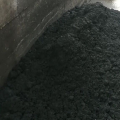|
|
 發表於 2013-11-11 20:34:08
|
顯示全部樓層
發表於 2013-11-11 20:34:08
|
顯示全部樓層
本帖最後由 蘇少儀 於 2013-11-11 06:35 編輯
哇!!!短時間找不到交集............................
http://animalrangeextension.mont ... ine/2-Det-quant.htm
Determining Quantity: Carcass Fat Free Lean
A. Characteristics of Composition
When comparing carcasses it would be ideal to determine the proportion of muscle by dissection and chemical analysis. This is not practical in most contests. Therefore, regression equations using the measurements discussed below are used to estimate carcass lean composition.
B. Measurements to be Taken:
1. Hot carcass weight:
Hot carcass weight should be obtained immediately after dressing and prior to carcass chilling. Equations for estimating carcass lean were developed using skin-on, head-off carcasses. Section IIC provides carcass weight adjustments if other carcass processing techniques were used.
2. Fat Depth (including skin) over the loin at the 10th rib
Rib the carcass as explained in Section IV. Divide the longest axis of the loin muscle cross-sectional surface into quarters. Measure the fat depth to the nearest .05-inch at 3/4 the distance from the mid-line side to the belly side of the loin muscle. Measure from the edge of the loin muscle to the outer edge of, and perpendicular to, the skin. For best accuracy, rib and measure both sides and average the values. In actuality, both sides are rarely measured for county contests.
Make subjective adjustments to account for mechanical disfigurations and (or) unusual fat distributions. If the skin has been removed, add 0.1 inch (or other factor) to adjust to a skin-on basis. In Montana, most skinning is done using a knife rather than by pulling. Therefore 0.15 is a more appropriate adjustment.
3. Loin Muscle Area
Rib the untrimmed carcass perpendicular to the backbone between the 10th and 11th ribs as explained in Section IV . Determine the area to the nearest .05-square inch by using a plastic grid directly on the cross-sectional surface or by tracing on acetate paper prior to measuring with the grid. Swine grids have 20 dots per square inch. Rib and measure both sides and average the values for best accuracy. However, this is rarely done for county contests. [see Figure 1b.]
4. Visual Carcass Muscling Score
Assign the appropriate USDA carcass muscling score as illustrated below. Make every effort to minimize the effects of fatness when assessing these muscling scores.
Score 1 = Thin Carcass is angular in shape. The hams and shoulders are tapered and narrow in appearance and lack bulge and thickness. The muscle-to-bone ratio would be low.
Score 2 = Intermediate Carcass would be intermediate between Scores 2 and 3. Most carcasses are within this range.
Score 3 = Thick Carcass is bulging in appearance. The hams and shoulders are significantly thicker (as a result of more muscle, NOT fat) than the loin region. They are convex in shape and the muscle-to-bone ratio would be high.
5. Last rib Fat Thickness
Last rib fat thickness is measured to the nearest .05 inch at the carcass mid-line opposite the last rib. Measure perpendicular to and including the skin and the first (outer), second (middle), and third (inner; if present) layers of fat exposed on the split surface adjacent to the last rib. Do not include the connective tissue layer next to the vertebra.
Measurement from one side of the carcass is usually satisfactory, however, an average measurement taken on both sides will improve accuracy, particularly if the carcass is split off center.
In many carcasses the last rib measurement is within 0.1 inch of the 10th rib measurement. Recording both on skinned hogs may give a rough check for accuracy and is encouraged.
C. Carcass Adjustments for Differences in Dressing, Weighing, and Chilling Procedures.
It is important that the condition of the carcass at the time of evaluation be recorded. This allows correction of measurements to standard conditions. Computer software used in the Montana SOE Program will make the appropriate adjustment if measuring conditions are specified.
1. Scalding vs. skinning.
Scalding of pork carcasses should always be the first choice when collecting carcass data. Scalding pork carcasses results in more accurate data collection than skinning. However, skinning is often the only option in small plants and is the most common procedure in Montana. If pork carcasses are skinned, skins should be pulled (as opposed to skinning with a knife). Every effort should be made to prevent any fat from pulling off with the skin, especially over the loin region of the carcass. Special care should be taken with very lean carcasses because fat being pulled off with the skin is more likely on leaner carcasses. If pork carcasses are skinned, 0.10 inch or other factor should be added to fat thickness measurements to account for skin thickness. In Montana, most skinning is with a knife and 0.15 is a more appropriate adjustment. The person evaluating the carcass should also subjectively adjust fat thickness on individual carcasses as necessary to account for variations in fat removal.
2. Equations for predicting carcass composition were developed using head-off carcasses. Therefore, head-off dressing procedures are preferred. If the head has been left on, adjust weight as discussed below.
3. Hot carcass weight should be obtained to the nearest pound immediately after dressing and prior to carcass chilling. The carcasses should be weighed without any of the offal (liver, heart, tongue, kidney, leaf fat). Jowls and feet should be left on the carcass.
Hot carcass weights should be adjusted to a skin-on, head-off basis. If pork carcasses are skinned, the hot carcass weights should be multiplied by 1.06 to adjust to skin-on weight. If carcasses are head-on, the hot carcass weights should be multiplied by 0.94 to adjust to head-off weight. If the carcasses are skinned and head-on, no adjustment is necessary because skin-off, head-on carcasses weigh approximately the same as skin-on, head-off carcasses.
If a cold weight is taken, multiply cold, skin-on, head-off weight by 1.015 to adjust to a hot basis (most carcasses shrink 1.5%). Estimate and add any trim loss less than 5% of carcass weight. If trim loss is greater than 5%, eliminate the carcass from the contest.
4. There should be a minimum 24-hour chill time between slaughter and carcass evaluation to allow for accurate evaluation of pork muscle quality.
5. Validation of scale weights is important. Check or test weights should be placed on the scale to verify accuracy at the start of the evaluation. Scales should be tared for weight of hooks and trolleys.
It is recommended that average daily live gain and average daily lean muscle gain also be determined, as described in Section VI. This requires initial live weight and date in addition to the final live weight and date. This information helps evaluate live production efficiency and nutrient requirements.
D. Prediction Equation for Pounds of Standardized Fat-free Lean for Ribbed Carcasses:
Pounds of acceptable lean calculated on a fat-free basis =.
+8.588
-21.896 x 10th-rib backfat depth (inches)
+ 3.005 x 10th-rib loin eye area (sq. inches)
+ 0.465 x hot carcass wt. (lbs.)
Percentage of fat-free lean =
100 x (Lbs. of fat-free lean / Hot carcass wt.)
[Note: equations for utilizing ultrasound and other measurements are given in the full NPPC publication. It is not accurate to directly compare (or rank) values obtained using different formulas.]
1NOTE: The evaluation procedures, Fat Free Lean Equations, photos and Quality Standards in this factsheet were adapted with permission from “Pork Composition & Quality Assessment Procedures,” published in 2000 by National Pork Producers Council, Des Moines, Iowa.
|
|



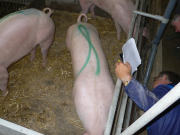
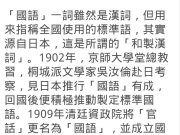
![越南非洲豬瘟疫苗蒙陰影 上百豬隻接種後死亡[轉貼]](data/attachment/block/3e/3e723490e252eebc3bc1a403febd226e.jpg)
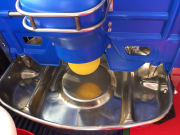
![[轉貼]從上市9頭到14頭 -- 我的養豬專業養成之路。](data/attachment/block/3c/3c17fd6b5c1b8cff34fdc7342238e082.jpg)
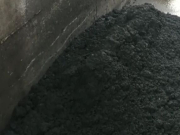
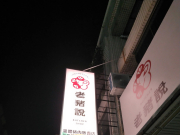
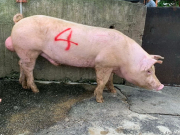
![[轉貼]這個倒霉王國,因為一隻老鼠慘遭滅國 .....](data/attachment/block/3f/3ffb7b6b8ec14613dc077bdd7603e3a5.jpg)
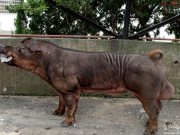


 IP卡
IP卡 狗仔卡
狗仔卡 發表於 2013-11-11 20:34:08
發表於 2013-11-11 20:34:08
 顯身卡
顯身卡 [信息未更新]
[信息未更新] 樓主
樓主 發表於 2013-11-11 21:43:47
發表於 2013-11-11 21:43:47


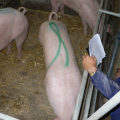
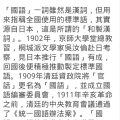
![越南非洲豬瘟疫苗蒙陰影 上百豬隻接種後死亡[轉貼]](data/attachment/block/d2/d2539d8909b33105a4f3e3b9b2e8a659.jpg)
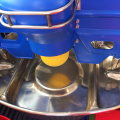
![[轉貼]從上市9頭到14頭 -- 我的養豬專業養成之路。](data/attachment/block/81/819f9b837f86a7e00498f8d95b8b9176.jpg)
